Drawing blood is a common medical procedure, but choosing the right needle size is crucial for patient comfort and the integrity of the blood sample. The ideal needle size depends on several factors, including the patient's vein size, the type of blood test, and the volume of blood needed. This guide will delve into the specifics of needle sizes used in phlebotomy, answering common questions and providing essential information for healthcare professionals and those curious about the process.
What are the standard needle sizes for venipuncture?
Standard needle gauges for venipuncture range from 21 gauge to 23 gauge. A 21 gauge needle is a common choice because it offers a good balance between sample collection speed and patient comfort. A 23 gauge needle is often preferred for patients with smaller or more fragile veins, minimizing bruising and discomfort. Larger gauge numbers indicate smaller needle diameters. While 25-gauge needles exist, they are less frequently used for routine blood draws due to the potential for hemolysis (rupturing of red blood cells). Using a needle too small can also increase the likelihood of clotting within the needle.
What size needle is used for blood tests?
The needle size selected for blood tests depends primarily on the volume of blood required. For routine tests requiring smaller blood volumes, a 23-gauge needle is often sufficient. For tests needing larger volumes or if the patient has smaller veins, a 21-gauge needle might be used. However, the phlebotomist's experience and the patient's vein condition play a critical role in selecting the most appropriate gauge.
What needle gauge is best for difficult draws?
For patients with difficult veins – those that are small, fragile, deep, or roll easily – using a smaller gauge needle such as a 23-gauge or even a 25-gauge (with appropriate skill and experience) might seem counterintuitive but can often be more successful. A smaller needle's smaller diameter may cause less trauma and collapse to the vein. However, the phlebotomist’s skill and technique are paramount; even a smaller needle will not work if the insertion technique is poor.
Are there different needle sizes for different blood collection tubes?
While the type of blood collection tube doesn't directly dictate the needle size, the volume requirements associated with the tubes might influence the gauge selection. For example, if several large volume tubes are needed, a larger gauge needle (like a 21-gauge) might be preferred to reduce the overall draw time and decrease the likelihood of the vein collapsing before collecting all necessary samples. However, this is less a function of tube type and more a function of the total volume of blood to be collected.
What needle size is best for children?
For pediatric patients, a smaller gauge needle, such as a 23-gauge or even a 25-gauge (only with experienced professionals), is generally recommended due to their smaller veins. The selection depends heavily on the child's age and vein size, as well as the skill of the phlebotomist. Using the smallest possible appropriate gauge is crucial for patient comfort and minimizing trauma.
What are the risks of using the wrong needle size?
Using an inappropriately sized needle can lead to several complications:
- Hematoma: Too large a needle can cause excessive bleeding and bruising.
- Hemolysis: Using too small a needle can damage red blood cells, affecting test results.
- Vein Collapse: Too large a needle can collapse smaller veins, making blood collection difficult or impossible.
- Pain and discomfort: An incorrectly sized needle can cause more pain and discomfort to the patient.
- Increased risk of infection: Improper technique with any size needle can increase the risk of infection.
Disclaimer: This information is for educational purposes only and should not be considered medical advice. Always consult with qualified healthcare professionals for any medical concerns or procedures. Proper training and experience are essential for safe and effective blood collection.
